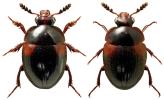Images:
A family of 93 small (1-7mm) round/oval beetles in Britain, largely found in association with fungi. Much of the biology and ecology of these beetles is unknown, partly because species-level identification is exceptionally difficult, particularly Leiodes and Colon species. There are four British subfamilies.
Subfamily Platypsyllinae has only one British representative, the brown, hairy Leptinus testaceus Müller. This has been found in various nests: those of bumblebees, birds, rodents and the ant Formica fuliginosa Latreille.
Coloninae contains a single genus in Britain, Colon, and nine brown, smoothly-oval species. The ecology and biology of these species is particularly poorly known and identification is difficult, especially of females: the most reliable method of identification is to examine the aedagus of the male.
Cholevinae has 34 members in Britain, and occur in decaying organic matter of various types. Most species of genus Choleva can be found in mammal nests; Nemadus colonoides (Kraatz) occurs in bird nests in tree rot-holes and Catopidius depressus (Murray) is found mostly in rabbit burrows. As with Coloninae, the aedagus is the primary identification tool, although in genus Choleva the male posterior trochanters and female genital sclerites are also characteristic.
Leiodinae has 49 shining black-brown round-oval species on the 2012 checklist, mostly mycophagous and many almost unknown. The tribe Leiodini have fossorial legs; they, along with the tribe Sogdini, live mostly underground where they feed on hypogeous fungi, including truffles (Tuber spp.). Other groups can be found in association with above-ground (epigeal) fungi and myxomycetes (slime moulds), including under fungoid tree bark and in leaf litter. As with the other Leiodidae, dissection of the male is the most reliable method of identification.




